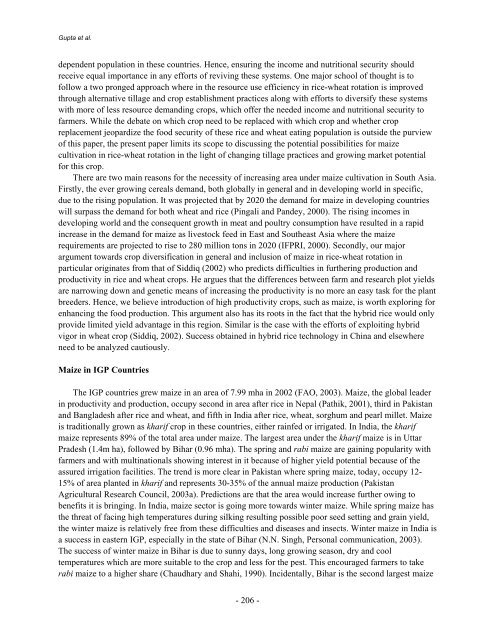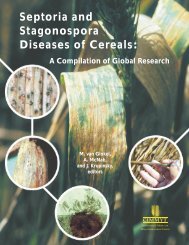Section 3 (Crop Management)
Section 3 (Crop Management)
Section 3 (Crop Management)
You also want an ePaper? Increase the reach of your titles
YUMPU automatically turns print PDFs into web optimized ePapers that Google loves.
Gupta et al.<br />
dependent population in these countries. Hence, ensuring the income and nutritional security should<br />
receive equal importance in any efforts of reviving these systems. One major school of thought is to<br />
follow a two pronged approach where in the resource use efficiency in rice-wheat rotation is improved<br />
through alternative tillage and crop establishment practices along with efforts to diversify these systems<br />
with more of less resource demanding crops, which offer the needed income and nutritional security to<br />
farmers. While the debate on which crop need to be replaced with which crop and whether crop<br />
replacement jeopardize the food security of these rice and wheat eating population is outside the purview<br />
of this paper, the present paper limits its scope to discussing the potential possibilities for maize<br />
cultivation in rice-wheat rotation in the light of changing tillage practices and growing market potential<br />
for this crop.<br />
There are two main reasons for the necessity of increasing area under maize cultivation in South Asia.<br />
Firstly, the ever growing cereals demand, both globally in general and in developing world in specific,<br />
due to the rising population. It was projected that by 2020 the demand for maize in developing countries<br />
will surpass the demand for both wheat and rice (Pingali and Pandey, 2000). The rising incomes in<br />
developing world and the consequent growth in meat and poultry consumption have resulted in a rapid<br />
increase in the demand for maize as livestock feed in East and Southeast Asia where the maize<br />
requirements are projected to rise to 280 million tons in 2020 (IFPRI, 2000). Secondly, our major<br />
argument towards crop diversification in general and inclusion of maize in rice-wheat rotation in<br />
particular originates from that of Siddiq (2002) who predicts difficulties in furthering production and<br />
productivity in rice and wheat crops. He argues that the differences between farm and research plot yields<br />
are narrowing down and genetic means of increasing the productivity is no more an easy task for the plant<br />
breeders. Hence, we believe introduction of high productivity crops, such as maize, is worth exploring for<br />
enhancing the food production. This argument also has its roots in the fact that the hybrid rice would only<br />
provide limited yield advantage in this region. Similar is the case with the efforts of exploiting hybrid<br />
vigor in wheat crop (Siddiq, 2002). Success obtained in hybrid rice technology in China and elsewhere<br />
need to be analyzed cautiously.<br />
Maize in IGP Countries<br />
The IGP countries grew maize in an area of 7.99 mha in 2002 (FAO, 2003). Maize, the global leader<br />
in productivity and production, occupy second in area after rice in Nepal (Pathik, 2001), third in Pakistan<br />
and Bangladesh after rice and wheat, and fifth in India after rice, wheat, sorghum and pearl millet. Maize<br />
is traditionally grown as kharif crop in these countries, either rainfed or irrigated. In India, the kharif<br />
maize represents 89% of the total area under maize. The largest area under the kharif maize is in Uttar<br />
Pradesh (1.4m ha), followed by Bihar (0.96 mha). The spring and rabi maize are gaining popularity with<br />
farmers and with multinationals showing interest in it because of higher yield potential because of the<br />
assured irrigation facilities. The trend is more clear in Pakistan where spring maize, today, occupy 12-<br />
15% of area planted in kharif and represents 30-35% of the annual maize production (Pakistan<br />
Agricultural Research Council, 2003a). Predictions are that the area would increase further owing to<br />
benefits it is bringing. In India, maize sector is going more towards winter maize. While spring maize has<br />
the threat of facing high temperatures during silking resulting possible poor seed setting and grain yield,<br />
the winter maize is relatively free from these difficulties and diseases and insects. Winter maize in India is<br />
a success in eastern IGP, especially in the state of Bihar (N.N. Singh, Personal communication, 2003).<br />
The success of winter maize in Bihar is due to sunny days, long growing season, dry and cool<br />
temperatures which are more suitable to the crop and less for the pest. This encouraged farmers to take<br />
rabi maize to a higher share (Chaudhary and Shahi, 1990). Incidentally, Bihar is the second largest maize<br />
- 206 -









